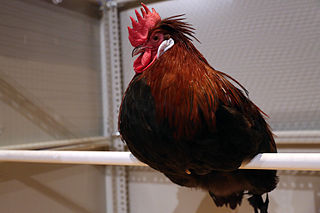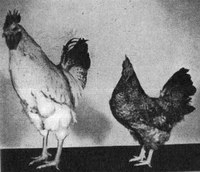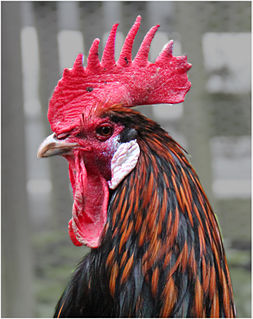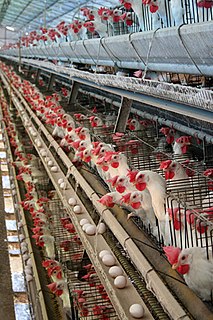 W
WThe chicken is a type of domesticated fowl, a subspecies of the red junglefowl. Chickens are one of the most common and widespread domestic animals, with a total population of 23.7 billion as of 2018. up from more than 19 billion in 2011. There are more chickens in the world than any other bird or domesticated fowl. Humans keep chickens primarily as a source of food and, less commonly, as pets. Originally raised for cockfighting or for special ceremonies, chickens were not kept for food until the Hellenistic period.
 W
WA capon is a cockerel (rooster) that has been castrated or neutered, either physically or chemically, to improve the quality of its flesh for food, and, in some countries like Spain, fattened by forced feeding.
 W
WChickens and their eggs have been used extensively as research models throughout the history of biology. Today they continue to serve as an important model for normal human biology as well as pathological disease processes.
 W
WA chicken coop or hen house is a small house where, typically, female chickens or other fowl are kept safe and secure. There are nest boxes found inside the hen houses for egg-laying, and perches on which the birds can sleep.
 W
WA chicken can be hypnotized, or put into a trance, with its head down near the ground, by drawing a line along the ground with a stick or a finger, starting at the beak and extending straight outward in front of the chicken. If the chicken is hypnotized in this manner, it will continue to stare at the line, remaining immobile for as long as 30 minutes. Other methods of inducing this state are also known. Ethologists refer to this state as 'tonic immobility' i.e. a natural state of semi-paralysis that some animals enter when presented with a threat, which is probably a defensive mechanism intended to feign death, albeit rather poorly.
 W
WThe chicken or the egg causality dilemma is commonly stated as the question, "which came first: the chicken or the egg?" The dilemma stems from the observation that all chickens hatch from eggs and all chicken eggs are laid by chickens. "Chicken-and-egg" is a metaphoric adjective describing situations where it is not clear which of two events should be considered the cause and which should be considered the effect, to express a scenario of infinite regress, or to express the difficulty of sequencing actions where each seems to depend on others being done first. Plutarch posed the question as a philosophical matter in his essay "The Symposiacs", written in the 1st century CE.
 W
WA chicken tractor is a movable chicken coop lacking a floor. Chicken tractors may also house other kinds of poultry. Most chicken tractors are a lightly built A-frame which one person can drag about the yard. It may have wheels on one or both ends to make this easier.
 W
WA cockfight is a blood sport between two cocks, or gamecocks, held in a ring called a cockpit. The history of raising fowl for fighting goes back 6,000 years. The first documented use of the word gamecock, denoting use of the cock as to a "game", a sport, pastime or entertainment, was recorded in 1634, after the term "cock of the game" used by George Wilson, in the earliest known book on the sport of cockfighting in The Commendation of Cocks and Cock Fighting in 1607. But it was during Magellan's voyage of discovery of the Philippines in 1521 when modern cockfighting was first witnessed and documented by Antonio Pigafetta, Magellan's chronicler, in the kingdom of Taytay.
 W
WCockfighting in India primarily takes place in January, coinciding with Makar Sankranti. The practice is widespread in the coastal districts of Andhra Pradesh, including Krishna, Guntur, East Godavari and West Godavari districts, despite being illegal in India.
 W
WThe Cosmopolitan Chicken Project is a global, transdisciplinary and transtemporal examination of the themes of biocultural diversity and identity through the interplay of art, science and beauty. In the CCP Koen Vanmechelen cross-breeds chicken breeds from different countries. His ultimate goal is the creation of a Cosmopolitan Chicken carrying the genes of all the planet's chicken breeds. Much more than a mere domesticated animal, the chicken is art in itself.
 W
WCrested chickens are a special ornamental group of chicken breeds, which are characterised by a tuft ("crest") of elongated feathers on the head.
 W
WFalconry is the hunting of wild animals in their natural state and habitat by means of a trained bird of prey. Small and larger animals are hunted; squirrels and rabbits often fall prey to these birds. There are two traditional terms used to describe a person involved in falconry: a falconer flies a falcon; an Austringer flies a hawk or an eagle. In modern falconry, the red-tailed hawk, the Harris's hawk, and the peregrine falcon are some of the more commonly used birds of prey. The practice of hunting with a conditioned falconry bird is also called hawking or gamehawking, although the words hawking and hawker have become used so much to refer to petty traveling traders, that the terms falconer and falconry now apply to most use of trained birds of prey to catch game. Many contemporary practitioners still use these words in their original meaning, however.
 W
WDelayed-feathering in chickens is a genetically determined delay in the first weeks of feather growing, which occurs normally among the chicks of many chicken breeds and no longer manifests itself once the chicken completes adult plumage.
 W
WDominant CZ is a hen hatchery company in the Czech Republic. The main store is in Studenec, but it has another 39 stores in Czech Republic, which are in Bílovec, Blatnice pod Svatým Antonínkem, Borek, Bratkovice, Bravantice, Březina, Býškovice, Častotice, Čepí, Černovice, Čížkrajice, Dolany, Dolní Cerekev, Háj ve Slezsku, Hradišťany, Jezernice, Kobeřice, Kraselov, Kravaře, Lipník, Nymburk, Oldřichovice, Otročín, Palkovice, Prakšice, Prostějov, Řimovice, Skalice, Staré Prachatice, Stěžírky, Strážov, Trutnov, Uhlířov, Velká, Veltěže, Veselí nad Lužnicí, Volevčice and Vsetín. The company was founded in 1989. The purpose of the company is to hatch hybrid hens, which lay more than 250 eggs a year, which are imitating the non-hybrid species of hens, which do not die permaturely, which are not aggressive, which are well feathered and which are all the same size. The hybrids are always hatched from two non-hybridized hens. The hens start to lay eggs in the 20th–23rd week of their life. Excluding the Czech Republic, it works in 49 more countries in the world. Hens hatched by this company are favorite, because of their easy breeding and higher egg-laying and lifetime unlike other hens.
 W
WDwarfism in chickens is an inherited condition found in chickens consisting of a significant delayed growth, resulting in adult individuals with a distinctive small size in comparison with normal specimens of the same breed or population.
 W
WFeather pecking is a behavioural problem that occurs most frequently amongst domestic hens reared for egg production, although it does occur in other poultry such as pheasants, turkeys, ducks, broiler chickens and is sometimes seen in farmed ostriches. Feather pecking occurs when one bird repeatedly pecks at the feathers of another. The levels of severity may be recognized as mild and severe. Gentle feather pecking is considered to be a normal investigatory behaviour where the feathers of the recipient are hardly disturbed and therefore does not represent a problem. In severe feather pecking, however, the feathers of the recipient are grasped, pulled at and sometimes removed. This is painful for the receiving bird and can lead to trauma of the skin or bleeding, which in turn can lead to cannibalism and death.
 W
WFeral chickens are derived from domestic chickens who have returned to the wild. Like the red junglefowl, feral chickens will roost in bushes in order to avoid predators at night.
 W
WSome terms used for the feathers of poultry are identical to those used for feathers of other birds, while others are specific to poultry. They include:
 W
WLong-crowing chicken breeds are characterised by the unusually long-drawn-out crow of the cocks, which may in some cases last for up to 60 seconds. The oldest references to long-crowing cocks are from China. Long-crowing breeds are found in the Far East, in Turkey, in the Balkans and in western Germany.
 W
WChicken manure is the feces of chickens used as an organic fertilizer, especially for soil low in nitrogen. Of all animal manures, it has the highest amount of nitrogen, phosphorus, and potassium. Chicken manure is sometimes pelletized for use as a fertilizer, and this product may have additional phosphorus, potassium or nitrogen added. Optimal storage conditions for chicken manure include keeping it in a covered area and retaining its liquid, because a significant amount of nitrogen exists in the urine.
 W
WA pea comb is one type of chicken combs. It manifests as three connected rows of caruncles in the form of conjoined pea-like protrusions. Pea combs begin at the base of the beak and extend towards the top of a chicken's head. Pea combs are smaller than other combs length-wise and do not extend upwards. More prominent types of combs are more likely to suffer from frostbite, leading to theories that pea combs may be beneficial for breeds common in colder climes. This type of comb is present in Araucana, Ameraucana, Buckeye, Brahma, Cornish, and Cubalaya breeds.
 W
WPoultry farming is the form of animal husbandry which raises domesticated birds such as chickens, ducks, turkeys and geese to produce meat or eggs for food. It has originated from the agricultural era. Poultry – mostly chickens – are farmed in great numbers. More than 60 billion chickens are killed for consumption annually. Chickens raised for eggs are known as layers, while chickens raised for meat are called broilers.
 W
WIn agriculture, poultry litter or broiler litter is a mixture of poultry excreta, spilled feed, feathers, and material used as bedding in poultry operations. This term is also used to refer to unused bedding materials. Poultry litter is used in confinement buildings used for raising broilers, turkeys and other birds. Common bedding materials include wood shavings, sawdust, peanut hulls, shredded sugar cane, straw, and other dry, absorbent, low-cost organic materials. Sand is also occasionally used as bedding. The bedding materials help absorb moisture, limiting the production of ammonia and harmful pathogens. The materials used for bedding can also have a significant impact on carcass quality and bird performance.
 W
WA rooster, also known as a cockerel or cock, is a male gallinaceous bird, with cockerel being younger and rooster being an adult male chicken.
 W
WA Rubber Chicken is a prop used in comedy. The phrase is also used as a description for food served at speeches, conventions, and other large meetings, and as a metaphor for speechmaking.
 W
W"Why did the chicken cross the road?" is a common riddle joke, with the answer being "To get to the other side". It is an example of anti-humor, in that the curious setup of the joke leads the listener to expect a traditional punchline, but they are instead given a simple statement of fact. "Why did the chicken cross the road?" has become iconic as an exemplary generic joke to which most people know the answer, and has been repeated and changed numerous times over the course of history.